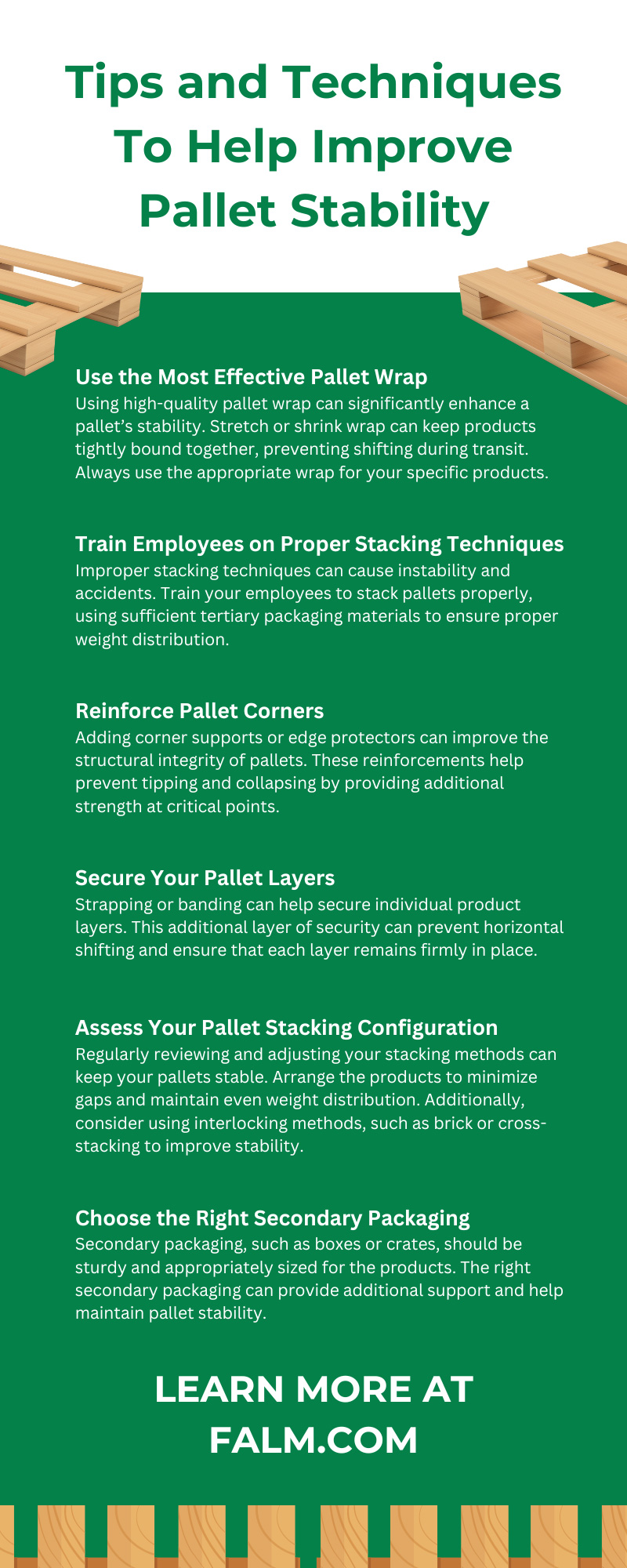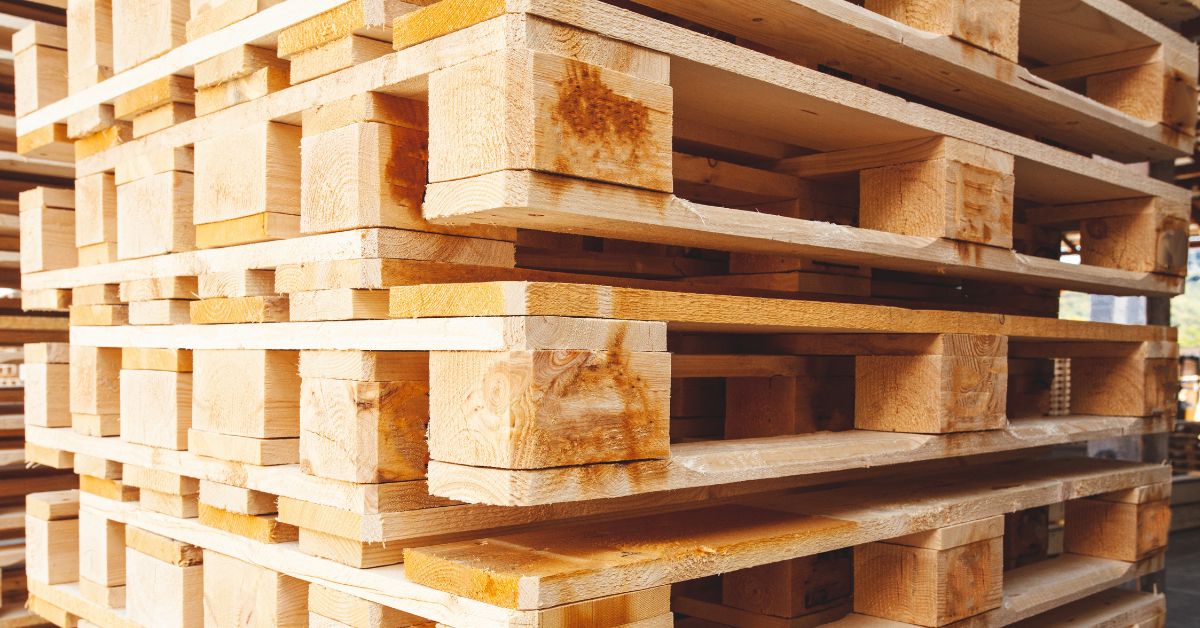Maintaining pallet stability is crucial for many businesses, especially those in the logistics sector. It can greatly enhance efficiency, safety, and cost-effectiveness. Here are some tips and techniques to help improve pallet stability in your operations.
What Is Pallet Stability?
Pallet stability refers to the ability of a pallet to maintain its structure and keep the stacked products intact during transportation and storage. This helps goods arrive at their destination in the same condition they were shipped in. Stable pallets minimize movement and reduce the risk of damage, making them essential for any business that ships products regularly.
Why Pallet Stability Is Important
As a business owner, identifying any potential problems in the supply chain that could impact operations is important. Unstable pallets can cause many problems, including product loss and workplace accidents. Let’s explore the top three reasons why pallet stability is vital.
Prevents Product Loss During Shipping and Handling
With unstable pallets, products can shift, causing damage or even complete loss of goods. Stable pallets keep items secure and intact during shipping and handling, reducing the likelihood of costly damage.
Reduces Pallet Accidents for Warehouse Employees
Unstable pallets can cause workplace accidents, endangering the safety of warehouse employees. A toppled pallet can cause serious injuries, resulting in lost workdays and potential legal liabilities. By maintaining pallet stability, businesses can create a safer work environment for their staff.
Improves the Efficiency and Cost-Effectiveness of Warehouse Operations
Stable pallets streamline warehouse operations, making it easier to stack, store, and retrieve goods. The increased organization results in fewer delays and less time spent dealing with damaged products, significantly improving overall efficiency and cost-effectiveness in the warehouse.
Common Causes of Pallet Instability
To improve pallet stability you must first understand what causes instability. Most of these elements are within your company’s control, giving you ample opportunity to make the required changes. Here are the most common factors causing pallet instability.
Force of Impact
During transit, pallets can experience sudden jolts or impacts, causing products to shift. Rough handling by shipping personnel or poor road conditions during transportation can cause these shifts.
Movement Between Product Layers
If there is inadequate friction between product layers, they can slide over each other, destabilizing the entire pallet. This destabilization is often a result of poor stacking techniques or insufficient packaging materials.
Too Much or Too Little Tertiary Packaging
Tertiary packaging plays a significant role in maintaining pallet stability. Too much can make the pallet difficult to stack, while using too little can result in insufficient support.
Product Stacking and Weight Distribution
Incorrect stacking methods and uneven weight distribution are major contributors to pallet instability. Workers should stack products with heavier items on the bottom and lighter items on top to create a balanced load.
Changes To Packaging Materials
Switching to different packaging materials without re-evaluating their effect on pallet stability can cause problems. Ensure that new materials provide the same or better stability than previous ones.
Inconsistent Pallet Quality
Pallet quality is a crucial factor in maintaining stability. Damaged, warped, or inferior pallets can create an unstable base for stacking products.
Inconsistent dimensions or structural integrity can lead to shifting and collapsing under the load’s weight. Regularly inspect and maintain pallets to guarantee they meet the required standards for durability and strength.
How Using the Pallet Design System Can Help Improve Pallet Stability
The Pallet Design System (PDS) is a valuable tool for enhancing pallet stability. It provides detailed guidelines and specifications for designing pallets that can withstand various stresses during shipping and handling.
By using PDS, businesses can create more robust and secure pallets, reducing the risk of instability. Additionally, PDS can help identify potential issues in the design process, allowing manufacturers to make adjustments before production. These adjustments can improve pallet stability and minimize the risk of product loss, accidents, and inefficiencies.
The Importance of Running Pallet Stability Testing
Testing pallet stability is one of the best ways to spot potential issues before they become costly problems. Regular testing can help pallet suppliers fine-tune your pallet designs and help your business improve its loading methods, ensuring maximum stability and safety.
It also provides data that businesses can use to make informed decisions about packaging materials and techniques. Running pallet stability tests in different conditions, such as during transportation and storage, can help businesses prepare for real-world scenarios.
The information gathered during these tests can help prevent product damage and losses, saving time and money. Overall, running pallet stability testing is a crucial step in improving the efficiency and effectiveness of warehouse operations.
Additional Tips for Improving Pallet Stability
In addition to the strategies mentioned above, consider these additional tips for improving pallet stability. With our advice, you can provide sufficient product protection and address all potential hazards of your palletized supply chain.
Use the Most Effective Pallet Wrap
Using high-quality pallet wrap can significantly enhance a pallet’s stability. Stretch or shrink wrap can keep products tightly bound together, preventing shifting during transit. Always use the appropriate wrap for your specific products.
Train Employees on Proper Stacking Techniques
Improper stacking techniques can cause instability and accidents. Train your employees to stack pallets properly, using sufficient tertiary packaging materials to ensure proper weight distribution.
Reinforce Pallet Corners
Adding corner supports or edge protectors can improve the structural integrity of pallets. These reinforcements help prevent tipping and collapsing by providing additional strength at critical points.
Secure Your Pallet Layers
Strapping or banding can help secure individual product layers. This additional layer of security can prevent horizontal shifting and ensure that each layer remains firmly in place.
Assess Your Pallet Stacking Configuration
Regularly reviewing and adjusting your stacking methods can keep your pallets stable. Arrange the products to minimize gaps and maintain even weight distribution. Additionally, consider using interlocking methods, such as brick or cross-stacking to improve stability.
Choose the Right Secondary Packaging
Secondary packaging, such as boxes or crates, should be sturdy and appropriately sized for the products. The right secondary packaging can provide additional support and help maintain pallet stability.
First Alliance Logistics Management: Your Preferred Supplier of Stabilized Pallets
First Alliance Logistics Management is a trusted partner for businesses needing a reliable wooden pallet supplier. Our expertise in pallet production allows you to focus on your business operations, knowing the pallets we send you will fulfill your transportation and storage needs.
Following these tips and techniques to help improve pallet stability can minimize product damage, enhance workplace safety, and streamline warehouse operations. At First Alliance Logistics Management, we’re committed to providing high-quality, stable pallets that meet all your logistical needs. For more information about our pallet manufacturing and repair services, visit our website today.


